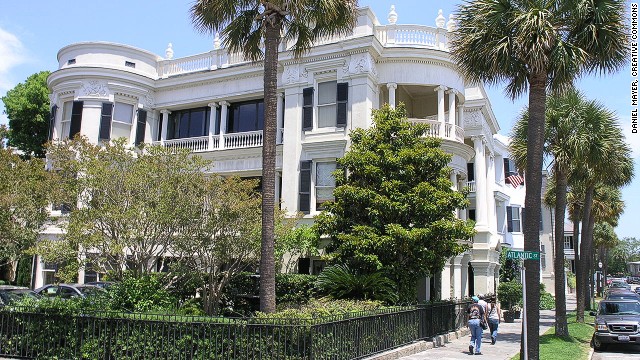Editor's note: "The City" is a CNN special series that profiles the sustainable urban future of five cities over five days. Watch the show every day during our special theme week starting Monday, Aug 19 on "World Business Today" at 1300 GMT and "Connect The World" at 2000 GMT.
(CNN) -- The United States, land of freedom and opportunity, is also the land of scowling faces and folded arms, according to a new poll.
Travel magazine Conde Nast Traveler has unveiled the results of its annual readers' choice survey.
More than 46,000 readers gave their opinions last year on everything from favorite airlines to best hotels and friendliest and unfriendliest cities.
It's the latter category that might cause the most surprises, with U.S. cities dominating the "unfriendly" list.
Newark, New Jersey, is the unfriendliest city in the world according to the survey.

 5. Charleston, South Carolina Score: 91.5 The only U.S. city that made it into the top 10 friendliest cities. Charleston took first place in a previous poll to find the friendliest cities in the United States.
5. Charleston, South Carolina Score: 91.5 The only U.S. city that made it into the top 10 friendliest cities. Charleston took first place in a previous poll to find the friendliest cities in the United States.  4. Queenstown, New Zealand Score: 91.8 "Excellent outdoor vibe," "down-to-earth, nice people," "a feast for the eyes and the palate" and "a tranquil and peaceful town," were some of the comments from Conde Nast Traveler's pollees. New Zealand hasn't had as much love since the "Lord of the Rings" trilogy.
4. Queenstown, New Zealand Score: 91.8 "Excellent outdoor vibe," "down-to-earth, nice people," "a feast for the eyes and the palate" and "a tranquil and peaceful town," were some of the comments from Conde Nast Traveler's pollees. New Zealand hasn't had as much love since the "Lord of the Rings" trilogy.  3. Thimpu, Bhutan Score: 93.7 It's hard to score low when your king has such a charming smile and there's a national policy in place to promote "gross national happiness."
3. Thimpu, Bhutan Score: 93.7 It's hard to score low when your king has such a charming smile and there's a national policy in place to promote "gross national happiness."  2. Hobart, Tasmania Score: 95.4 "The most beautiful country and people," one reader said.
2. Hobart, Tasmania Score: 95.4 "The most beautiful country and people," one reader said.  1. Florianopolis, Brazil Score: 95.8 The city was highly regarded for its friendly locals and fabulous scenery. "The area was stunningly beautiful," said one respondent.
1. Florianopolis, Brazil Score: 95.8 The city was highly regarded for its friendly locals and fabulous scenery. "The area was stunningly beautiful," said one respondent.  5. Kuwait City, Kuwait Score: 25.4 The travel magazine quoted one reader in the survey: "I typically avoid travel to Kuwait unless there's no other choice. One of the most unfriendly places in the Middle East."
5. Kuwait City, Kuwait Score: 25.4 The travel magazine quoted one reader in the survey: "I typically avoid travel to Kuwait unless there's no other choice. One of the most unfriendly places in the Middle East."  4. Luanda, Angola Score: 25 The city has "construction everywhere with signs of basic poverty next to enormous wealth," according to one reader.
4. Luanda, Angola Score: 25 The city has "construction everywhere with signs of basic poverty next to enormous wealth," according to one reader.  3. Oakland, California Score: 23.1 Readers of Corde Nast described Oakland as having a split personality. It's "growing very hip" but it's also unfriendly and dirty, readers claimed.
3. Oakland, California Score: 23.1 Readers of Corde Nast described Oakland as having a split personality. It's "growing very hip" but it's also unfriendly and dirty, readers claimed.  2. Islamabad, Pakistan Score: 17.9 Despite its low rating as a friendly city, the readers' reviews of Islamabad were not all negative. Readers said the city has a "peaceful green and soothing environment."
2. Islamabad, Pakistan Score: 17.9 Despite its low rating as a friendly city, the readers' reviews of Islamabad were not all negative. Readers said the city has a "peaceful green and soothing environment."  1. Newark, New Jersey Score: 13.4 Unhappy fliers could be the reason for this exceptionally low score. "I visited Newark on business and would not recommend this city for anything, except a cheaper/less busy airport to fly into while visiting other cities," Corde Nast quoted one reader.
1. Newark, New Jersey Score: 13.4 Unhappy fliers could be the reason for this exceptionally low score. "I visited Newark on business and would not recommend this city for anything, except a cheaper/less busy airport to fly into while visiting other cities," Corde Nast quoted one reader. World's friendliest cities
World's friendliest cities
World's friendliest cities
World's friendliest cities
World's friendliest cities
World's least friendly cities
World's least friendly cities
World's least friendly cities
World's least friendly cities
World's least friendly cities
HIDE CAPTION
 U.S. cities rule 'unfriendliest cities' list
U.S. cities rule 'unfriendliest cities' list "Newark is best known for being the site of an airport near New York, and for many of our readers, that's the only reason to stop there," says Conde Nast Traveler.
In total, five U.S. cities were voted into the top 10 unfriendly cities list and eight made the top 20.
Oakland, California (third), "has an image problem and a split personality" according to a reader who answered the survey.
New Haven, Connecticut (seventh), home of Yale University, is the city of "rude, unfriendly folks;" Detroit (eighth) was called the "armpit of the world" by one reader and Atlantic City, New Jersey (ninth), was dismissed as a "pale shadow of Las Vegas."
Other cities in the list include Islamabad in Pakistan (second least friendly), Luanda in Angola (fourth), Kuwait City (fifth) Lome in Togo (sixth) and Tangier in Morocco (tenth).
What do you think? Tell us about your own friendly or unfriendly travel experiences in the comments section below.
Conde Nast Traveler stresses that its rankings are inspired by factors including location, political perception, size and language barriers, and don't necessarily correspond to rude behavior of locals.
But enough badmouthing.
The survey also announces the friendliest cities in the world.
Florianopolis, the island city in Brazil, is the world's friendliest city according to the poll.
Hobart in Tasmania followed in second place and Thimpu in Bhutan wrapped up the top three.
One U.S. city made it into the top 10 friendliest cities -- Charleston, South Carolina.
Standing fifth in the global list, Charleston was also voted the friendliest city in the United States in a previous poll.
The world's unfriendliest cities
20. Caracas, Venezuela
19. Bethlehem, Palestine
18. Casablanca, Morocco
17. Wilmington, Delaware
16. Moscow
15. Riyadh, Saudi Arabia
14. Shenzhen, China
13. Albany, New York
12. Los Angeles
11. Guangzhou, China
10. Tangier, Morocco
9. Atlantic City, New Jersey
8. Detroit
7. New Haven, Connecticut
6. Lome, Togo
5. Kuwait City
4. Luanda, Angola
3. Oakland, California
2. Islamabad, Pakistan
1. Newark, New Jersey
The world's friendliest cities
20. Cork, Ireland
20. Asheville, North Carolina
18. Edinburgh, Scotland
16.Savannah, Georgia
16. Auckland, New Zealand
14. Victoria, British Columbia
14. Galena, Illinois
13. Dublin, Ireland
12. Christchurch, New Zealand
11. Chiang Mai, Thailand
9. Ubud, Bali, Indonesia
9. Kilkenny, Ireland
8. Mandalay, Myanmar
6. Margaret River, Australia
6. Paro, Bhutan
5. Charleston, South Carolina
4. Queenstown, New Zealand
3. Thimpu, Bhutan
2. Hobart, Tasmania
1. Florianopolis, Brazil
Also on CNN: 20 biggest travel mistakes
This article is taken from CNN.com
 5. Charleston, South Carolina Score: 91.5 The only U.S. city that made it into the top 10 friendliest cities. Charleston took first place in a previous poll to find the friendliest cities in the United States.
5. Charleston, South Carolina Score: 91.5 The only U.S. city that made it into the top 10 friendliest cities. Charleston took first place in a previous poll to find the friendliest cities in the United States.  4. Queenstown, New Zealand Score: 91.8 "Excellent outdoor vibe," "down-to-earth, nice people," "a feast for the eyes and the palate" and "a tranquil and peaceful town," were some of the comments from Conde Nast Traveler's pollees. New Zealand hasn't had as much love since the "Lord of the Rings" trilogy.
4. Queenstown, New Zealand Score: 91.8 "Excellent outdoor vibe," "down-to-earth, nice people," "a feast for the eyes and the palate" and "a tranquil and peaceful town," were some of the comments from Conde Nast Traveler's pollees. New Zealand hasn't had as much love since the "Lord of the Rings" trilogy.  3. Thimpu, Bhutan Score: 93.7 It's hard to score low when your king has such a charming smile and there's a national policy in place to promote "gross national happiness."
3. Thimpu, Bhutan Score: 93.7 It's hard to score low when your king has such a charming smile and there's a national policy in place to promote "gross national happiness."  2. Hobart, Tasmania Score: 95.4 "The most beautiful country and people," one reader said.
2. Hobart, Tasmania Score: 95.4 "The most beautiful country and people," one reader said.  1. Florianopolis, Brazil Score: 95.8 The city was highly regarded for its friendly locals and fabulous scenery. "The area was stunningly beautiful," said one respondent.
1. Florianopolis, Brazil Score: 95.8 The city was highly regarded for its friendly locals and fabulous scenery. "The area was stunningly beautiful," said one respondent.  5. Kuwait City, Kuwait Score: 25.4 The travel magazine quoted one reader in the survey: "I typically avoid travel to Kuwait unless there's no other choice. One of the most unfriendly places in the Middle East."
5. Kuwait City, Kuwait Score: 25.4 The travel magazine quoted one reader in the survey: "I typically avoid travel to Kuwait unless there's no other choice. One of the most unfriendly places in the Middle East."  4. Luanda, Angola Score: 25 The city has "construction everywhere with signs of basic poverty next to enormous wealth," according to one reader.
4. Luanda, Angola Score: 25 The city has "construction everywhere with signs of basic poverty next to enormous wealth," according to one reader.  3. Oakland, California Score: 23.1 Readers of Corde Nast described Oakland as having a split personality. It's "growing very hip" but it's also unfriendly and dirty, readers claimed.
3. Oakland, California Score: 23.1 Readers of Corde Nast described Oakland as having a split personality. It's "growing very hip" but it's also unfriendly and dirty, readers claimed.  2. Islamabad, Pakistan Score: 17.9 Despite its low rating as a friendly city, the readers' reviews of Islamabad were not all negative. Readers said the city has a "peaceful green and soothing environment."
2. Islamabad, Pakistan Score: 17.9 Despite its low rating as a friendly city, the readers' reviews of Islamabad were not all negative. Readers said the city has a "peaceful green and soothing environment."  1. Newark, New Jersey Score: 13.4 Unhappy fliers could be the reason for this exceptionally low score. "I visited Newark on business and would not recommend this city for anything, except a cheaper/less busy airport to fly into while visiting other cities," Corde Nast quoted one reader.
1. Newark, New Jersey Score: 13.4 Unhappy fliers could be the reason for this exceptionally low score. "I visited Newark on business and would not recommend this city for anything, except a cheaper/less busy airport to fly into while visiting other cities," Corde Nast quoted one reader. 








